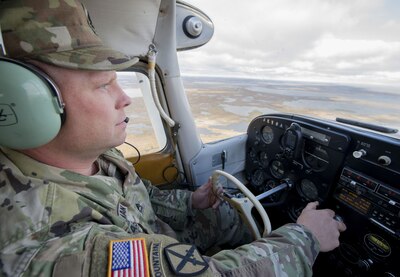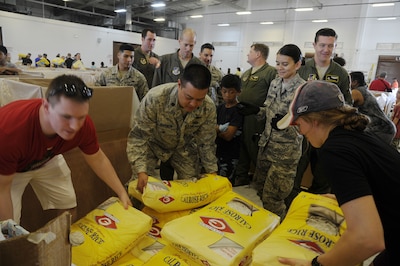By Sean Kimmons Army News Service
BETHEL, Alaska, Dec. 12, 2017 — As a new recruiter working
remote Alaskan villages scattered across an area larger than many U.S. states,
Army Sgt. 1st Class Robert Masterman was on a path to defeat.
An infantryman by trade, Masterman volunteered for the solo
mission covering roughly 50,000 square miles in southwest Alaska, where travel
between villages is primarily by plane or boat. A typical Army recruiter may
have an area of just 40 miles, he said, with a car and good roads to easily get
around.
In the face of those challenges, he hit only half of his
first-year target to get eight Army recruits into the Alaska Army National
Guard.
“I straight up failed,” he said. “I kind of floundered, and
I had no idea what I was doing out here by myself.”
Originally from the back woods of Maine, the 42-year-old
soldier has always loved the outdoors. His interest in Alaska developed when he
was young, and as he grew older, he decided to move to the “Last Frontier” to
attend college.
He later joined the Army and landed at Fort Wainwright,
Alaska, for his first duty station. Over time, he grew fond of the local way of
life and easily made friends. Today, he has two children who are half native
Alaskan.
It didn’t matter, he said, that he was a white
Irish-American who did not grow up there. “They accepted me 100 percent,” he
added. “My heart is filled with the native culture here.”
After he took a hiatus to help his family back in Maine, he
returned to serve in the Alaska National Guard. As he worked part-time as a
brigade plans noncommissioned officer, he pursued another passion of his:
flying. He purchased his own single-engine propeller aircraft and used
education benefits from the Army to rack up flight hours and obtain a
commercial pilot’s license.
At the time, the Alaska National Guard was looking to put a
recruiter back in Bethel, which is about 500 miles east of Anchorage, to reach
out to Alaska natives living in the Yukon-Kuskokwim delta region. With a high
concentration of families who have served in the military and have a knack for
outdoor survival skills, it was thought the area could be a hotbed for quality
recruits.
“We’ve got the arctic experts here -- all around us,” he
said, adding there has been a renewed interest for that expertise as Russia
builds up its forces in the Arctic. “The easy part is to teach them to be
soldiers, and then they become our arctic warfare specialists.”
His leaders knew he was familiar with the culture and had
his own plane, so they asked him if he wanted to work as a full-time recruiter.
He accepted the job and fully embraced it. “I believe in the mission, believe
in protecting this country, this state and having the network of National Guard
soldiers out here to protect the communities,” he said.
Various Modes of Transportation
As the only recruiter he is aware of who uses his own plane
for work, Masterman said he has enjoyed the ride so far in his three years of
recruiting. He also has a boat, as well as a government-owned snowmobile and
truck that he can drive on frozen waterways to reach villages in the winter.
“There’s nothing typical about this job,” he said. “I think
that’s the biggest attraction for me to this job, because it’s always different
and it’s always keeping me on my toes.”
While on recruiting trips, Masterman travels with a “go box”
filled with Army pamphlets, T-shirts, mugs and other swag he hands out to
potential recruits. But it’s his uniform that attracts people to him, including
veterans who chat with him about today’s Army.
“If I go out there in civilian clothes, I'll get a ‘hello’
or a ‘hi’ here and there,” he said. “But if I show up in this uniform, it’s a
magnet. They know what the uniform means, they know what it represents.”
He said he strives to be a straight shooter when it comes to
what recruits can expect in the Army, not only because he is an ambassador for
the service, but also because he plans to stay in the area.
“I can’t go out and make a bad name for myself,” he said. “I
want to go out there and be perfectly honest with everybody. I’m not just some
person in a uniform and coming out here to talk to you about putting a uniform
on. I'm a community member.”
Helping With Junior ROTC
Masterman can often be seen at the Bethel Regional High
School, where he helps to teach physical education as a substitute teacher, and
to train Junior ROTC students.
Retired Army Sgt. 1st Class Amile Summers, who is in charge
of 45 JROTC students with one other instructor, said the extra help from the
recruiter has been huge.
Besides training the students, he said, Masterman also is
working on a sponsorship for the high school’s Raider team, which competes in
Junior ROTC competitions around the country. He even set up a field trip out to
a drop zone for students to see Army paratroopers in action.
“It seems small to us, but to the kids it’s a huge deal,”
Summers said. “The kids here are very receptive, and they appreciate knowing
that someone cares enough to be here, especially when you show them that you're
not here for just one or two years and [then] you’re out of here.”
A former recruiter himself, Summers said Masterman has spent
more time at the school than he has ever seen a recruiter do before. “He has
shown that he’s committed to the community, not just from his recruiting
standpoint, but from his activity in the school,” Summers said.
Masterman’s extra efforts at the school don’t distract him
from his job as a recruiter. Instead, they actually prove to be an advantage.
Students at the school, all potential recruits, come up to him and talk to him
about the Army. He even helped Summers’ son sign up as an infantryman.
Army Pvt. Amile Summers Jr., who recently graduated from
initial entry training, said he and other students were glad to have Masterman
on hand so they could pepper him with questions.
“It provides them with the opportunity to speak with
somebody who is actually in the Army,” the 18-year-old said of having a
recruiter on site. “Instead of learning from the instructors, who are retired,
they get to know what the Army is like today.”
Second Chances
Many obstacles still exist when recruiting alone in the vast
region, which has poor internet and cell phone service.
Yupik, one of Alaska’s native languages, is the primary
language in the region, so many potential recruits struggle to score well on
the Armed Services Vocational Aptitude Battery test, which is given in English.
Recognizing the arctic survival skills and history of military service among
the population here, the Army started a pilot program to give a limited number
of overrides to recruits with low ASVAB scores to help with recruiting efforts.
“You have to prove that you’re native Alaskan, grew up here
and educated in a rural educational system,” Masterman said of the pilot
program.
In addition, medical issues may flag a potential recruit,
due to the lack of extensive medical care in the region. On top of that, many
do not have birth certificates, Social Security cards or even state
identification cards, which are required to join the Army, he said.
Before they ship out, Masterman takes recruits to Anchorage
to square them away with all their necessary documents. On average, he said, it
can take two months from meeting a recruit to the recruit being ready for basic
combat training. “Even though they’re an applicant and they’re not in uniform
yet, they’re still my soldier, and I take care of them,” he said.
In the case of Army Pfc. Aaron Olrun, Masterman went above
and beyond to help. Olrun walked up to Masterman’s booth at a Fourth of July
event last year and asked about the Army. At the time, he and his wife had
adopted a child, and he worked as a housekeeper for the Bethel hospital. “I was
having trouble with money,” Olrun admitted. “I was surviving off of whatever I
could.”
While Olrun said he had minor criminal offenses due to his
past alcohol addiction -- Alaska’s rate of alcohol dependence and abuse is
twice the national average, according to the National Alcoholism Center -- he
looked to turn a new leaf to support his family.
As with many other recruits, Masterman took him under his
wing. He went on to help him with his paperwork and get a job in the Army as a
unit supply specialist.
“That’s the job as the NCO. That’s not the recruiter
necessarily, but that’s the NCO,” the sergeant said. “I want them to understand
that there’s somebody here who is going to invest in their future as a
soldier.”
Olrun said the second chance he was given is not something
he intends to waste, as he plans to use the Army's education benefits to go to
college.
“I’m a better person than I was a year ago. I’m a lot more
disciplined, more respectful to family and friends,” he said. “I can look at my
past and see the stupid things I did. I know I'm not going to repeat them.”
Belief in the Product
The lackluster recruiting numbers Masterman saw in his first
year are now a thing of the past. His early failure kicked him “in the rear,”
he said, and he vowed to never let it happen again.
A resurgent Masterman pounded the pavement, and flew many
miles with his plane, to get face-to-face with potential recruits. He would
sometimes work up to 80 hours a week.
As he met more people and word got out, applicants began to
roll in. In his second year, he hit his target within six months. Then last
year, he had 16 recruits -- six more than his target. This fiscal year his
target is now up to 12.
“I’m not even stressing it any more,” he said, smiling. “I
have my feet under me, I got my battle rhythm, and I know I’m going to do it.”
The Army recently sent in another recruiter to help
Masterman with the deluge of applicants. While his fleet of vehicles, including
his own plane, helps him get around the region, he can only do so much compared
to a typical recruiter in the continental United States.
“I have the opposite problem that most recruiters have,” he
said. “They have trouble finding people who want to enlist. I’m buried in
applicants. It’s just difficult for me to get to them and go through the actual
enlistment process with them.”
What’s easy for Masterman is supporting the mission. He once
worked as a commercial salesman, but in his current role, he said he doesn’t
have to “fake the funk” when trying to sell the Army.
“I’ve been in the military for over half my life now, so
yes, I believe in the product, what our mission is, what we do, and I believe
the benefits the soldier can get out of this are immeasurable,” he said. “I
lived all the benefits. It is who I am, ... and I dread the day when I have to
take the uniform off.”









